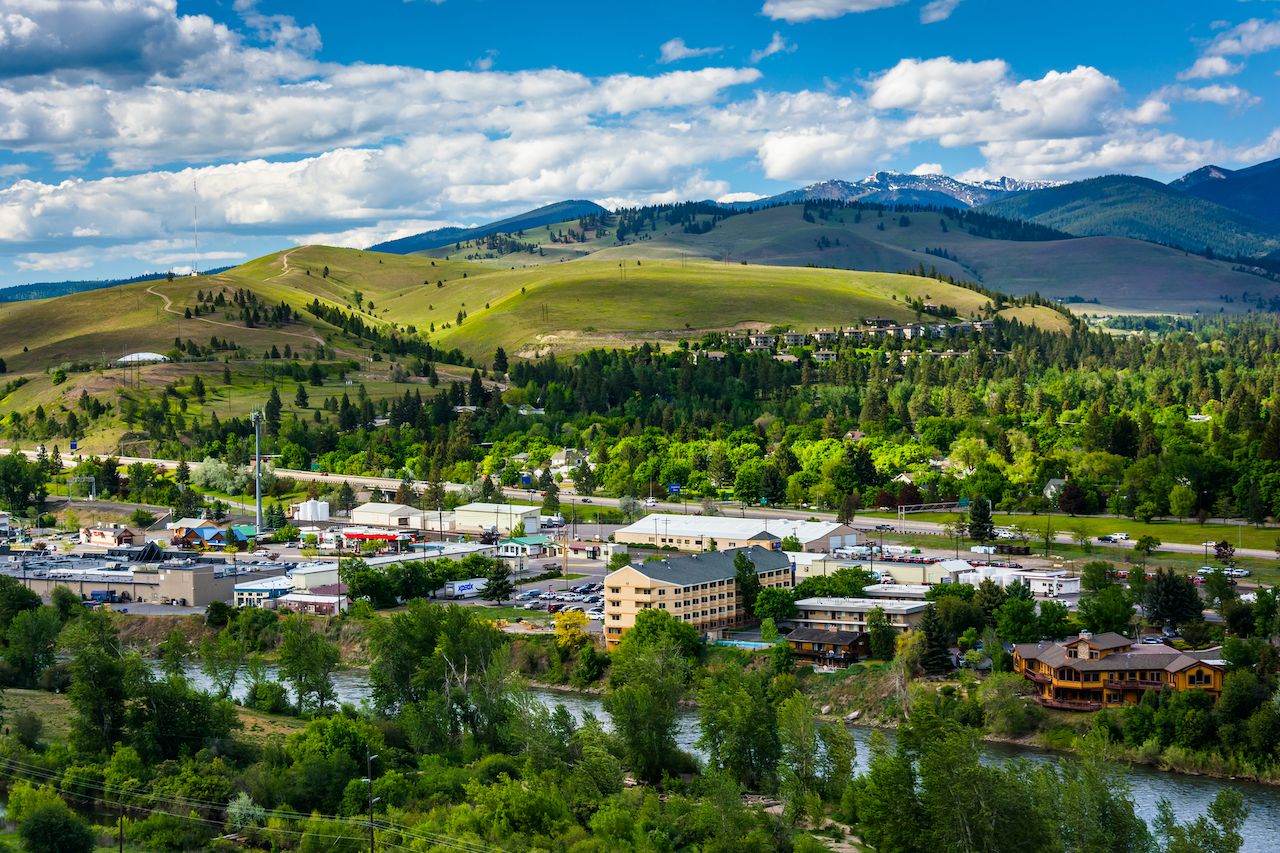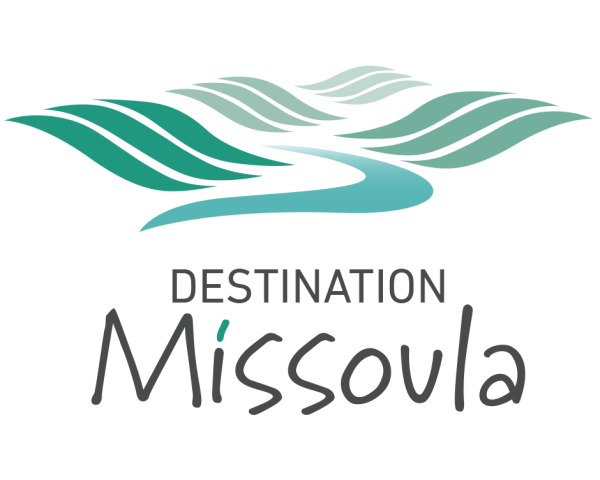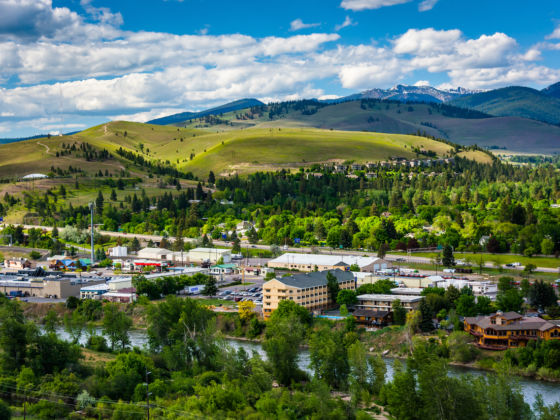https://www.youtube.com/watch?v=Uf3QE3qGMDM
1. It used to be entirely underwater.
Missoula sits at the bottom of a valley carved out during the last ice age. This valley was under 2,000 feet of water — known as Glacial Lake Missoula — until the bursting of a giant ice dam in Idaho some 15,000 years ago.
The landscape surrounding Missoula still has evidence of its glacial history if you look for it — like boulders the size of sedans, carried by glacial waters that some say flowed with a force 60 times that of the Amazon. And you can still see ancient shorelines on the slopes surrounding the city.
2. It’s super bicycle friendly.
For all the road bikes and fixies cruising the streets downtown, it’s easy to think you might be in Portland by mistake. Missoula has more than 20 miles of bike lanes throughout the city, was voted one of the ten best cycling cities in the US, and is home to the headquarters of the international Adventure Cycling Association, where visiting cyclists can snag a free ice cream and relax in their Cyclists’ Lounge.
3. There’s surfing…downtown.
Missoulians out for an evening stroll might stop on a bridge downtown to watch surfers ride waves in the middle of an otherwise gentle Clark Fork River. It’s not some sort of freak of nature, but rather the man-made Brennan’s Wave, built right in the middle of the city for the enjoyment of locals and visitors alike.
4. People have lived in these parts for 12,000 years.
The first people to inhabit the landscape surrounding present-day Missoula arrived long before the earliest European explorers. American Indians from the Salish tribe lived here some 12,000 years ago. Nemissoolatakoo, as they called the area, is where Missoula got its name — it translates to something along the lines of “river of ambush,” an apparent reference to inter-tribal fighting that was fairly frequent at the time.
5. Missoula produces some of the best craft beer in the country.

Photo: KettleHouse Brewing Company
Montana ranks fourth in the US for the number of craft breweries per capita. It’s not hard to figure out where Missoulians get their inspiration; you’ll see brews with names like Dancing Trout, Lost Peak Lager, and Moose Drool.
6. The world’s largest gold nugget was mined in the area.
The Atlantic Cable Quartz Lode, near Missoula, was home to what prospectors said was the biggest rock ever found. It sold for $19,000 near the end of the 19th century.
7. It’s more vegan friendly than you might think.
Montana has a steak and…more steak kind of a reputation, but Missoula is well supplied when it comes to vegetarian- and vegan-friendly options. Its restaurants’ offerings include vegan pizza, vegan donuts, and vegan polenta (and plenty of steak, of course), and there’s also a great farmers market if you’re looking to put something together on your own.
8. It was home to the first woman ever elected to Congress.
“I may be the first woman member of Congress, but I won’t be the last.” These are the words of Jeannette Rankin, who became the first woman in Congress in 1916. A hundred years later and there are over a hundred elected Congresswomen.
9. There are (at least) four ghost towns within easy driving distance.

Photo: Jon Bilous/Shutterstock
The Gold Rush was in full swing in Montana in the late 1800s. Legends of the lawlessness of the era are plenty, and as you walk the deserted streets of Garnet (open year round, $3/person, about an hour’s drive from Missoula), you can imagine the days of holdups and gunfights.
In the late 1800s a thousand people lived in Garnet, their hopes pinned on gold — the town’s amenities included a candy shop and 13 saloons. Within a few decades the gold was gone, and nearly everyone moved on, leaving behind a few tumbledown shacks that are still standing, the last hollow remnants of the Wild West.
10. You can still go gold panning.
Montana is home to some of the largest sapphire deposits in the world, and people today have a shot at digging up gems or panning for gold crumbs. There are public gold-panning areas set aside by the US Forest Service where you can test your technique. You can gold pan anywhere, of course, but in this area you might actually find something that glitters…and is actually gold.
11. Lewis and Clark passed by the site of present-day Missoula in 1805.
They camped at what they called “Travelers’ Rest,” which is now a state park in nearby Lolo, Montana. According to Captain Clark’s journals, the crew made some “celestial observations” and relaxed for a while. This park is the only site in the country where archaeologists have actually found physical evidence of a Lewis and Clark Expedition campsite.
12. It hosts an International Choral Festival.
For all its gold panning and roughneck lore, Montana has an arts-and-culture scene that rivals those of other much more populous states. The International Choral Festival started in 1987 and now draws choirs from around the world — from Austria, Bulgaria, Colombia, Finland, Latvia, Malaysia, Peru, and Spain — to Missoula. Catch this year’s festival July 13-16.
13. Bears are just a part of life here.

Photo: Martin Mecnarowski/Shutterstock
People and wildlife live alongside one another in much of Montana. It’s estimated there are about 13,000 black bears in the state, along with roughly 800 grizzlies. Missoulians know the ins and outs of living in bear country and keep up a website, Missoulabears.org, to let others know about sightings.
The Montana Department of Fish, Wildlife, and Parks also works to keep bears and humans a healthy distance apart, and spreads the word about the best way to visit bear country: Secure your food and garbage in your car or a bear-proof container, and don’t leave wildlife attractants lying around.
14. It’s not (that) cold in the winter.
Relatively speaking, anyway. Missoula sits west of the Rockies, and the combination of climatic factors at play gives the city something of its own microclimate, with spring flowers way ahead of much of the rest of the state and an uncanny knack for avoiding cold snaps in the winter.
15. A River Runs Through It was set in Missoula.
Penned by celebrated author Norman Maclean, the novel A River Runs Through It was adapted into an Academy Award-winning film in 1993, starring Brad Pitt and directed by Robert Redford. The story about the shenanigans of two brothers growing up in Missoula is a classic, especially for anyone who romanticizes the sleepy joy of fly fishing.
“The world is full of bastards,” proclaims the more rabble-rousing brother, “the number increasing rapidly the further one gets from Missoula, Montana.”

